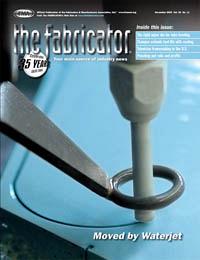- FMA
- The Fabricator
- FABTECH
- Canadian Metalworking
Categories
- Additive Manufacturing
- Aluminum Welding
- Arc Welding
- Assembly and Joining
- Automation and Robotics
- Bending and Forming
- Consumables
- Cutting and Weld Prep
- Electric Vehicles
- En Español
- Finishing
- Hydroforming
- Laser Cutting
- Laser Welding
- Machining
- Manufacturing Software
- Materials Handling
- Metals/Materials
- Oxyfuel Cutting
- Plasma Cutting
- Power Tools
- Punching and Other Holemaking
- Roll Forming
- Safety
- Sawing
- Shearing
- Shop Management
- Testing and Measuring
- Tube and Pipe Fabrication
- Tube and Pipe Production
- Waterjet Cutting
Industry Directory
Webcasts
Podcasts
FAB 40
Advertise
Subscribe
Account Login
Search
Details on Domex 700 MC
Joint prep, welding this extra-HSLA steel
- By Mikael Reinberth
- November 8, 2005
- Article
- Cutting and Weld Prep
 |
I'm a welding engineer at a company that recently upgraded one of its applications to the extra-high-strength steel Domex® 700 MC. What do you recommend regarding joint preparation and welding of Domex 700 MC?
Milling and thermal cutting (gas, plasma, or laser cutting) are the most common joint preparation methods. Joint preparation on Domex 700 MC is the same as it is on mild steels—no preheating is needed. Thermal cutting produces a thin oxide film on the joint surface that should be removed before welding.
You haven't mentioned which welding method you are going to use, but you can use all common fusion welding methods with this steel. Gas metal arc welding (GMAW) is the most common method used. If you use flux-cored arc welding (FCAW) rutile wires, select a wire that produces low (maximum 10ml per 100 g) hydrogen content in the weld metal.
Regarding filler metal, if a butt weld is subjected to high transverse forces, the filler metal must be matched or overmatched to ensure adequate strength of the welded joint. You can use undermatched filler metal on Domex 700 MC in these instances:
- If the weld is in a low-stress area.
- For fillet welds.
- For welding to an ordinary mild steel.
- If the weld reinforcement is not ground down.
- In most joints subjected to fatigue loads.
- If lower weld metal hardness is required.
When Domex 700 MC is welded, soft zones form in the heat-affected zone (HAZ). These arise as a result of changes in the microstructure. Sheet thickness, heat input, and working temperature determine the soft zones' width and hardness. Thin sheet, high heat input, and high working temperature can lead to a wider zone and lower strength.
If you use normal heat input and do not preheat the workpiece, these soft zones normally have no impact on the strength of the weld. On tensile testing across a butt weld, for example, the increasing load will quickly lead to a three-axis stress condition in the soft zone, which prevents further deformation in these parts of the material. Therefore, failure won't occur in the soft zones, but will occur in the parent metal or in the weld metal.
If you want to know more about welding procedures for Domex 700 MC using different filler metals, visit www.ssabdirect.com.
Mikael Reinberth is a welding expert at SSAB Tunnplt AB's Knowledge Service Center/ Joining, SE-781 84 Borlnge, Sweden, 46-243-718-80, fax 46-243-715-73, mikael.reinberth@ssab.com, www.ssab.com.
About the Author
subscribe now

The Fabricator is North America's leading magazine for the metal forming and fabricating industry. The magazine delivers the news, technical articles, and case histories that enable fabricators to do their jobs more efficiently. The Fabricator has served the industry since 1970.
start your free subscription- Stay connected from anywhere

Easily access valuable industry resources now with full access to the digital edition of The Fabricator.

Easily access valuable industry resources now with full access to the digital edition of The Welder.

Easily access valuable industry resources now with full access to the digital edition of The Tube and Pipe Journal.
- Podcasting
- Podcast:
- The Fabricator Podcast
- Published:
- 04/16/2024
- Running Time:
- 63:29
In this episode of The Fabricator Podcast, Caleb Chamberlain, co-founder and CEO of OSH Cut, discusses his company’s...
- Industry Events
16th Annual Safety Conference
- April 30 - May 1, 2024
- Elgin,
Pipe and Tube Conference
- May 21 - 22, 2024
- Omaha, NE
World-Class Roll Forming Workshop
- June 5 - 6, 2024
- Louisville, KY
Advanced Laser Application Workshop
- June 25 - 27, 2024
- Novi, MI































